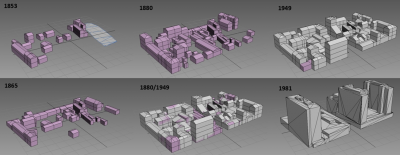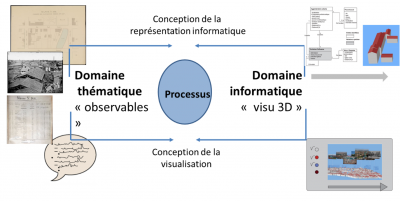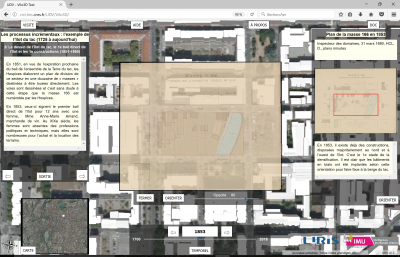Vilo3D Project
The Urban Fabric: From processes to their 3D representations
Anne-Sophie Clémençon (CR, CNRS, EVS), Gilles Gesquière (Pr, Lyon2, LIRIS), Hélène Mathian (IR, CNRS, EVS), John Samuel (CPE Lyon, LIRIS) and Sylvie Servigne (MCF, INSA, LIRIS) members of LabEx IMU
Understanding the processes of the urban fabric is a fundamental challenge in anticipating and forecasting its evolutions. We argue that this understanding must integrate thematic, qualitative, domain knowledge, with symbolic and numerical approaches that allow knowledge to be abstracted and modeled. In this framework, an approach initiated with the Vilo3D project proposed by the EVS (Environnements, Villes et sociétés) laboratory and the LIRIS laboratory consisted in identifying how the observations collected by researchers could find a computer representation and in particular give rise to elements of representation, based on the work of Anne-Sophie Clémençon on the evolution of the Left Bank between 1755 and our contemporary period. The first representations below led to a certain number of questions concerning the representation of evolutions in a 4D (temporal 3D) environment, in particular the question of the representation of events/processes, uncertainty/certainty, the interweaving of processes at different levels. Elements created by the team are presented below and demonstrate the evolution of the islet of the lake.

All of these questions have demonstrated the need to return to the process of the urban fabric itself, and to co-construct these representations ranging from the data observable by the historian and the geographer to the data that can be modeled and represented by the computer scientist, as illustrated below.

These technical choices were based on an application available in a browser in order to be able to collaborate and co-construct around the same model. The iTowns platform, co-developed by the IGN, the Oslandia company and the LIRIS served as the basis for this experiment.

Acknowledgements
This work was carried out with the support of the LABEX IMU (ANR-10-LABX-0088) of the University of Lyon, within the framework of the program “Investissements d’Avenir” (ANR-11-IDEX-0007) managed by the Agence Nationale de la Recherche (ANR). It financed the internships of Clément Chagnot (2016) and Emmanuel Schmück (2017). This work is based on the iTowns framework developed by the IGN, Oslandia and LIRIS.